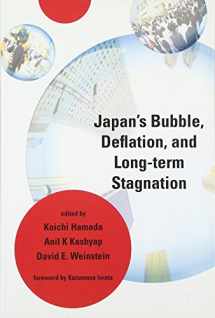
Japan's Bubble, Deflation, and Long-Term Stagnation
ISBN-13:
9780262014892
ISBN-10:
0262014890
Edition:
Illustrated
Author:
Koichi Hamada, Anil K. Kashyap, David E Weinstein
Publication date:
2010
Publisher:
Mit Pr
Format:
Hardcover
420 pages
FREE US shipping
Book details
ISBN-13:
9780262014892
ISBN-10:
0262014890
Edition:
Illustrated
Author:
Koichi Hamada, Anil K. Kashyap, David E Weinstein
Publication date:
2010
Publisher:
Mit Pr
Format:
Hardcover
420 pages
Summary
Japan's Bubble, Deflation, and Long-Term Stagnation (ISBN-13: 9780262014892 and ISBN-10: 0262014890), written by authors
Koichi Hamada, Anil K. Kashyap, David E Weinstein, was published by Mit Pr in 2010.
With an overall rating of 4.2 stars, it's a notable title among other
books. You can easily purchase or rent Japan's Bubble, Deflation, and Long-Term Stagnation (Hardcover) from BooksRun,
along with many other new and used
books
and textbooks.
And, if you're looking to sell your copy, our current buyback offer is $0.35.
Description
New perspectives on Japan's “lost decade” viewed in the context of recent financial turmoil.Japan's economic bubble burst in the early 1990s, and the country entered its famous “lost decade”―a period of stagnation and economic disruption that persisted until 2003. The current declines in global equity and real estate markets have eerie parallels to Japan's economic woes of the 1990s. If we are to avoid repeating Japan's experience on a global scale, we must understand what happened, why it happened, and the effectiveness (or ineffectiveness) of Japan's policy choices. In this volume, prominent economists―Japan specialists and others―bring state-of-the-art models and analytic tools to bear on these questions. The essays generate new facts and new findings about Japan's lost decade. As much of the research shows, the slowdown can be broken down into two phases: a typical recession, followed by a breakdown in the economy likely due to insufficient restructuring, which is not well described by conventional models. The contributors offer forceful arguments showing that Japan's experience, and the unconventional―sometimes unsuccessful―measures adopted by Japan's government and central bank, offer valuable lessons for our post-boom world.ContributorsKenn Ariga, Robert Barsky, Diego Comin, Robert Dekle, Kyoji Fukao, Koichi Hamada, Takeo Hoshi, Ryo Kambayashi, Anil K Kashyap, Takao Kato, Satoshi Koibuchi, Philip R. Lane, John Muellbauer, Kiko Murata, Maurice Obstfeld, Ryosuke Okazawa, Joe Peek, Ulrike Schaede, David E. Weinstein


We would LOVE it if you could help us and other readers by reviewing the book
Book review

Congratulations! We have received your book review.
{user}
{createdAt}
by {truncated_author}


